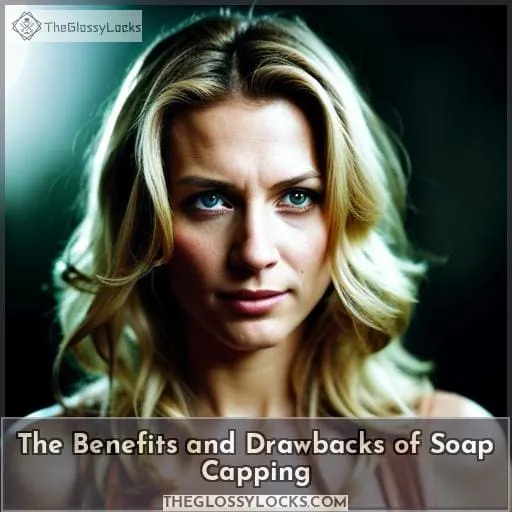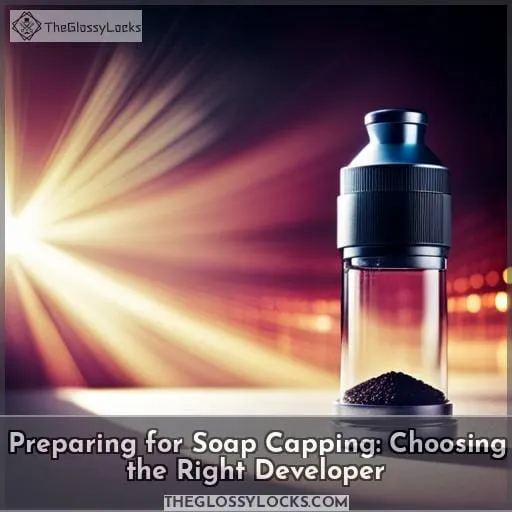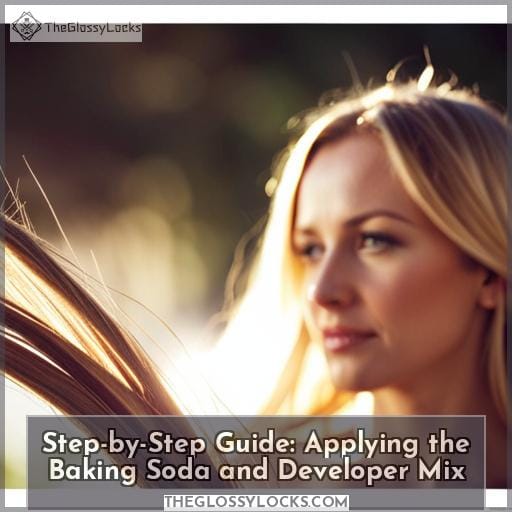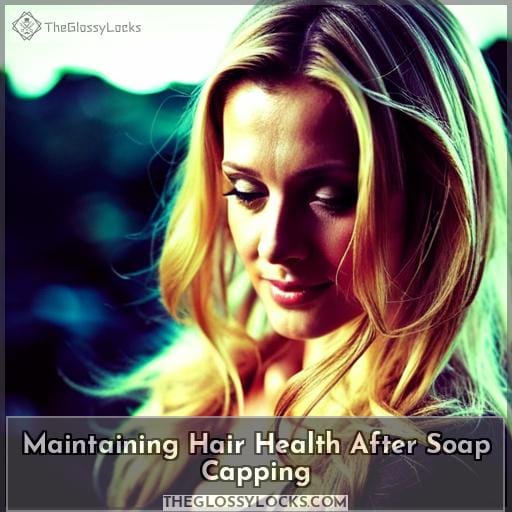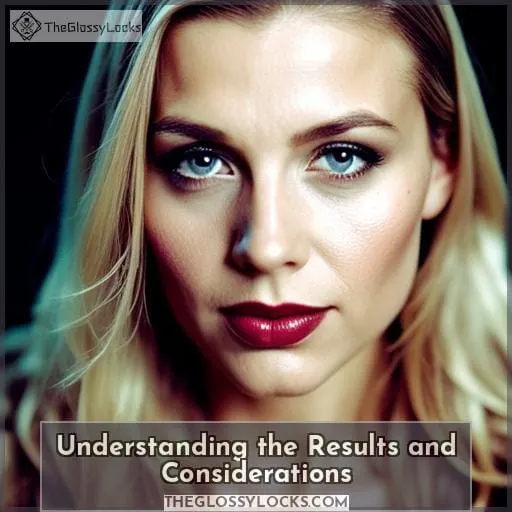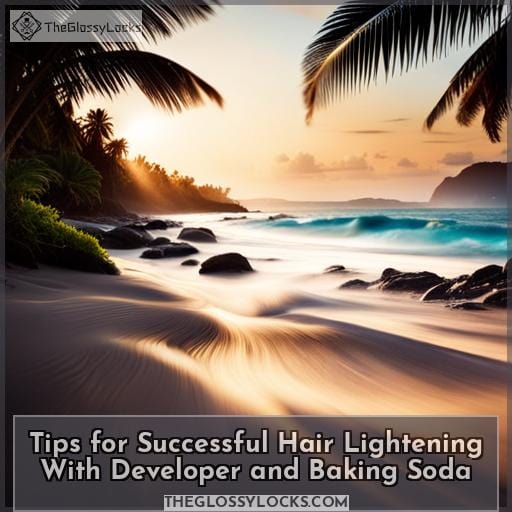This site is supported by our readers. We may earn a commission, at no cost to you, if you purchase through links.

By mixing bleach and color developer together, you can use a technique called soap capping or shampoo capping, also known as bleach bathing. This method can be used to remove color from your hair or refresh an existing dye job.
It’s important to note that this technique has both pros and cons depending on your hair type. Fine or dry strands are especially vulnerable when exposed too often over time, as it can cause damage eventually.
To safely start this process without compromising on results, make sure that the strength of your chosen developer is suitable for lift purposes. Additionally, it’s crucial to conduct strand tests to determine how long each application should last before rinsing out.
Table Of Contents
- Key Takeaways
- What is Soap Capping and How Does It Work?
- The Benefits and Drawbacks of Soap Capping
- Preparing for Soap Capping: Choosing the Right Developer
- The Baking Soda and Developer Mix for Hair Lightening
- Step-by-Step Guide: Applying the Baking Soda and Developer Mix
- Maintaining Hair Health After Soap Capping
- Understanding the Results and Considerations
- Alternatives to Soap Capping: Natural Lightening Methods
- Tips for Successful Hair Lightening With Developer and Baking Soda
- Conclusion
Key Takeaways
- Lightening hair with developer and baking soda is a bleach-free method.
- Choose the appropriate developer strength based on the desired lift.
- Conduct strand tests to determine the timing for the best results.
- Be cautious to prevent excessive dryness and breakage by limiting exposure time and using a deep conditioner.
What is Soap Capping and How Does It Work?
Soap Capping is a bleach-free hair lightening technique that involves combining baking soda and developer to create a chemical solution for lifting color, allowing you to achieve the desired level of lift with various volumes depending on your hair type.
It offers several benefits over traditional bleaches, such as more precise results and less damage.
Developer selection is key when using this method. You should use 10 or 20 volume for 1-2 levels of lift, 30 volume for 3-4 levels (suitable for brown hairs), and 40 volume if drastic changes are needed from dark to platinum blonde.
Timing considerations should be taken into account since the duration varies based on developer strength. Typically, the solution should stay in place for between 20 and 45 minutes. Performing a strand test beforehand can determine how long it needs to stay in place before rinsing out thoroughly.
Maintaining healthy locks after treatment requires the use of nourishing shampoo and conditioner. Natural alternatives like lemon juice offer an attractive option due to their low risk profile, but they yield less dramatic results than baking soda and hydrogen peroxide combinations do.
Taking proper precautions during application will reduce potential damages associated with frequent treatments or excessive exposure time, ensuring beautiful highlights without sacrificing quality strands!
The Benefits and Drawbacks of Soap Capping
Soap capping is a popular bleach-free hair lightening technique that can offer great results. It involves mixing baking soda and developer to create a chemical solution for lightening the hair, though some drawbacks such as dryness and breakage should be taken into consideration when opting for this method.
Alternatives such as lemon juice or hydrogen peroxide are also available if you’re looking for more natural solutions.
Pros of soap capping
With soap capping, you can achieve a natural look with minimal damage – if done correctly. To maintain hair health and moisture balance, use pH neutralization after treatment and select developer variations for different levels of lift.
Alternatives like lemon juice or baking soda mixed with hydrogen peroxide are also available to reduce potential damage from strong developers or frequent applications.
Cons of soap capping
However, soap capping can lead to excessive dryness and breakage for people with thin or fine hair. Minimizing damage should be a priority when lightening hair. Alternative methods like lemon juice and hydrogen peroxide may be necessary if the baking soda mix is too harsh.
Hair hydration after treatments is essential, as well as maintaining proper pH balance by using vinegar or fruit-fresh products afterwards. Frequent applications will further increase the risk of damage, so it’s important to limit exposure time and wait at least 10 days before reapplying the process of lightening hair with developer and baking soda (soap capping).
Alternatives to soap capping
If you’re looking for an alternative to soap capping, consider natural methods like lemon juice or a mix of hydrogen peroxide and baking soda. Both options provide effective lightening without the potential damage associated with bleach powder.
To protect hair health and hydration levels, it’s important to use moisturizing conditioners after treatment. You can also try different developer volumes for varying lift effects, depending on your desired outcome.
Ultimately, these gentle alternatives will give you beautiful results while keeping your hair healthy. Just remember to do a strand test before applying the treatment to your entire hair.
Preparing for Soap Capping: Choosing the Right Developer
When preparing for soap capping, it’s important to consider the developer strength needed for the desired lift as well as timing. Performing a strand test is an ideal way to ensure optimal results and minimize hair damage from overexposure.
Developer strength for lift.
You can dramatically alter your hair’s hue and texture by choosing the right developer strength for lift. Consider developer selection carefully, as it affects pH balance and lightening results.
A 10 or 20 volume is best for 1-2 levels of lift, while a 30 volume works well on brown hair.
It is important to conduct a strand test before applying the developer to achieve the desired results. Additionally, always prioritize hair health after treatments. Take precautionary measures such as limiting exposure time and using a deep conditioner when treating with any level of developer strength to prevent damage caused by excessive dryness or breakage in thin, fine hairs.
Strand test for timing.
Take a strand test before tackling your mane with developer and baking soda to get the right timing. Doing so will give you accuracy in assessing how long it’ll take for color change, while maintaining hair health.
Use 10 or 20 volume developer for 1-2 levels of lift, 30 volume for 3-4 levels on brown hair, and 40 volume if you’re aiming for drastic changes like dark to platinum blonde.
Keep track until you reach optimal lightening; rinse off after that and use deep conditioner afterwards as well.
Preventing hair damage
Limit your exposure time to minimize damage and condition deeply afterward. To prevent hair damage when lightening with baking soda and developer, always perform a strand test first to determine the right volume of developer for your desired level of lift.
Ten or 20 volume is suitable for 1-2 levels while 30 can provide 3-4 levels on brown hair; 40 should be used sparingly as it creates drastic changes such as dark to platinum.
Be mindful that natural alternatives like lemon juice may also help lighten but require moisture balance, pH control, and frequent conditioning treatments afterward. Avoid using strong developers too frequently to avoid excessive dryness or breakage in thin fine hair types.
Keep these tips in mind when choosing an effective bleach alternative!
The Baking Soda and Developer Mix for Hair Lightening
Mixing up the right concoction of ingredients can give you a desirable hair transformation. Baking soda and developer are two of the most popular choices for lightening locks safely without bleach. When mixed together, baking soda and developer create an alkaline solution that opens up hair cuticles to lift color from within.
Depending on your desired shade, select a volume of developer between 10-40 strength – higher volumes will result in more drastic changes! When applying the mixture, be sure to wear gloves and leave it on for no longer than 45 minutes before rinsing thoroughly with shampoo and conditioner afterwards.
For optimal results, use nourishing products free from sulfates or harsh chemicals that could strip away moisture post-treatment as this is essential for healthy-looking tresses over time! To ensure effective application, consider using natural alternatives like lemon juice or hydrogen peroxide alongside baking soda instead; both help to reduce pH balance while lifting unwanted hues simultaneously.
With some patience (and perhaps even multiple applications), you can achieve luminous strands minus any damage – perfect for those seeking safe options when lightening their mane at home!
Step-by-Step Guide: Applying the Baking Soda and Developer Mix
It is important to know the basics before lightening your hair with baking soda and developer. Before attempting this technique, perform a strand test to determine the right developer and timing that will work best for you.
Be sure to limit exposure time in order to prevent damage, using a deep conditioner if necessary; duration varies based on the strength of the developer used (typically 20-45 minutes).
Performing a Strand Test
Before beginning the process, take a moment to perform a strand test for best results.
- 10 or 20 volume developer for 1-2 levels of lift
- 30 volume developer for 3-4 levels, suitable for brown hair
- 40 volume developer for drastic changes like dark to platinum. The test also helps with moisture maintenance and guarantees desired outcomes without excessive damage. Remember that even with this precautionary step taken beforehand, overuse can still lead to dryness and breakage – so use caution!
Timing and Duration
To ensure the best results, carefully monitor your timing and duration when applying the baking soda and developer mix. Developers come in different concentrations for varying levels of lift. 10 or 20 volume is suitable for 1-2 levels, while 30 or 40 brings 3-4 shades lighter.
A strand test can help you determine how long to leave it on, which typically varies from 20-45 minutes depending on strength. To avoid damage, limit exposure time and use a deep conditioner afterwards to maintain moisture balance in hair strands.
Natural lightening options like lemon juice are also available if desired, but they may take longer than chemical agents like baking soda with developer.
Precautions and Damage Prevention
Take precautions and monitor timing to prevent damage when lightening your locks. Strand testing is essential to determine the right developer, as well as exposure time. Limit exposure times for safety and use a deep conditioner afterward for moisture maintenance.
Consider natural alternatives like lemon juice or baking soda with hydrogen peroxide instead of strong developers, too much of which can cause dryness and breakage in thin hair types.
Maintaining Hair Health After Soap Capping
After soap capping with a developer and baking soda, it’s important to maintain the health of your hair. To do this, use a nourishing shampoo and conditioner, and consider opting for a more moisturizing conditioner for better results.
Nourishing Shampoo and Conditioner
After lightening, treat your hair with a nourishing shampoo and conditioner to keep it healthy. To maintain the moisture balance of freshly lightened strands, opt for deep conditioning treatments. Additionally, add an extra step to your hair care routine post-treatment by using products that are specifically designed for color-treated or chemically processed hair.
Lastly, pH-balanced shampoos can be helpful in restoring the natural oils in the scalp while maintaining vibrant colors longer after lightening with developer and baking soda.
Moisturizing Conditioner for Better Results
For deeper, lasting results, follow up your soap capping with a more moisturizing conditioner. This will help maintain moisture balance and pH levels in the hair after lightening it with developer and baking soda.
Doing a strand test prior to using any kind of hair color developer can also ensure that you’re using the right products for your desired outcome. Consider natural alternatives like lemon juice or hydrogen peroxide when lightening your hair without bleach powder for gentler results.
Choose shampoos and conditioning treatments carefully during this process to promote overall healthy growth while protecting from dryness or breakage caused by changes in pH levels from chemical-based products used during the lightening process.
When it comes to maintaining healthy tresses after soap capping, use nourishing shampoo paired with an intensively moisturizing conditioner so you don’t have any regrets about taking on this complicated yet rewarding beauty project!
Understanding the Results and Considerations
Lightening your hair with a developer and baking soda can be unpredictable, so it’s important to understand the results and considerations when using this method. Timing varies depending on the strength of the developer used, as well as your hair type.
If left on for too long, you may experience dryness or breakage in thin or fine hair. Furthermore, while results are generally less drastic than bleach powder lightening agents, they still require careful monitoring for the best effects.
Predictability and Timing
Understanding the predictability and timing of lightening your locks with a developer and baking soda mix can be tricky. A strand test is essential to assess the accuracy of your color results before taking the plunge.
Developer selection plays an important role in predicting lift levels for different hair types, while moisture maintenance helps protect delicate strands from excessive dryness or breakage. Timing also depends on texture and desired result: shorter times are generally recommended for thinner, fine hair than coarse textures.
Potential Dryness and Breakage
Be mindful of potential dryness and breakage, especially with thin or fine hair when using a baking soda mix. Choose the right developer for your hair type to minimize damage; 10 or 20 volume is best for 1-2 levels of lift, 30 volume works well on brown hair, while 40 volume can provide drastic changes.
Use moisturizing conditioners after lightening treatments to keep strands healthy and balanced in pH level. Natural alternatives such as lemon juice may also be used – but always prioritize moisture! Excessive dryness and breakage are possible, so use caution: limit exposure time for less damage, and allow at least ten days between applications if needed.
Comparing Results to Bleach Powder
Experience the dramatic transformations that come from bleach powder, without the damaging effects. Comparing developer and baking soda to bleach powder, both can lift hair color up to four levels – though with bleaching, you get faster results.
Developer mixtures still provide a gentler solution than pure bleach powder while offering similar outcomes in terms of lightening hair color.
Maintenance tips for preserving your locks include limiting exposure time, using deep conditioner, avoiding frequent applications, allowing at least ten days between treatments, and neutralizing pH after with vinegar or fruit-fresh products.
Natural alternatives like lemon juice or combining baking soda and hydrogen peroxide are also available if desired.
Alternatives to Soap Capping: Natural Lightening Methods
If you’re looking for a natural lightening method, consider trying lemon juice. It’s an effective and easy-to-use way to achieve lighter hair without the need for harsh chemicals like developers and baking soda.
Lemon Juice for Hair Lightening
Try lemon juice for a gentle, natural lightening effect that won’t leave your hair feeling dried out and damaged. This DIY application has several benefits. It’s low in acidity levels compared to other alternatives such as baking soda or developer-mixed bleach.
Its citric acid can help open the hair cuticle without causing damage to the scalp and strands.
While less effective than harsher chemicals like bleach powder or developer mixed with peroxide, lemon juice is still able to lighten your hair color by roughly one shade when used consistently over time.
Baking Soda and Hydrogen Peroxide
Unlock a brighter shade with baking soda and hydrogen peroxide for an all-natural lightening effect! Baking soda helps raise the hair pH to 9 or 10, opening up the cuticle of your strands. This allows for better penetration during the lightening process. Hydrogen peroxide is also used, which creates a chemical reaction that lifts color from hair in order to achieve desired results.
Keeping in mind your own hair health when using this method, it’s important to neutralize pH after with vinegar or fruit-fresh so as not to damage already fragile strands further due to adverse shampoo harshness following application.
With proper use, you can safely enhance natural highlights and create custom shades without compromising on the overall condition of locks!
Tips for Successful Hair Lightening With Developer and Baking Soda
Successful hair lightening with developer and baking soda requires understanding the varying levels of lift that different developers can provide. From 10 or 20-volume developer for 1-2 levels of lift to 40-volume developer for drastic changes, it’s essential to choose the right product to achieve desired results.
With any hair lightening treatment, however, prioritizing moisture and overall health should be a top priority.
Varying Levels of Lift With Different Developer Volumes
Discover the power of different developer volumes to create varying levels of lift for your tresses! Developer selection can make all the difference when lightening hair. 10-20 volume is suitable for 1-2 levels, while 30 volume works best on brown hair and 40 volume will give a drastic change.
Maintaining pH balance is crucial during treatment. Baking soda is used to open up cuticles, but too much exposure time could cause damage. After treatment, it is important to focus on moisture maintenance. Using nourishing shampoo and conditioner, or opting for more hydrating options, can help avoid dryness or breakage in thin/fine hair types.
Don’t forget to neutralize pH after treatment. Vinegar or fruit fresh can be used to protect chemically treated locks from harsh shampoos.
Prioritizing Hair Health and Moisture
After lightening treatments, prioritizing hair health and moisture is key to achieving the desired results. Hydrating your hair with deep conditioners helps prevent split ends and provides a better color result.
Keeping pH balance in check also restores shine to dull locks. Moisture maintenance should continue even after you’ve finished the lightening process, as this will help prevent damage from occurring over time.
Regularly using nourishing shampoos and moisturizing conditioners will keep your hair hydrated before any chemical treatment or subsequent bleaching processes begin again for another round of color change.
Avoiding Excessive Damage With Frequent Applications
Be mindful of the potential damage that can occur with frequent applications, particularly when using strong developers – like having a drop too many drinks at the party. To prevent hair damage, monitor application timing. Prioritize hair health and moisture balance.
Choose an appropriate developer for your desired lift level. Use conditioner to buffer dryness from baking soda or hydrogen peroxide mix.
Additionally, limit exposure time and use deep conditioning treatments between lightening sessions.
Conclusion
All in all, soap capping with baking soda and developer is an effective way to lighten hair without using bleach. It can yield stunning results, from 1-4 levels of lift depending on the developer strength and hair type.
However, it’s important to be cautious of potential drawbacks such as excessive dryness and breakage.
Remember to prioritize hair health and moisture after any lightening treatments. Frequent applications can cause damage, so it’s essential to be mindful of that.


